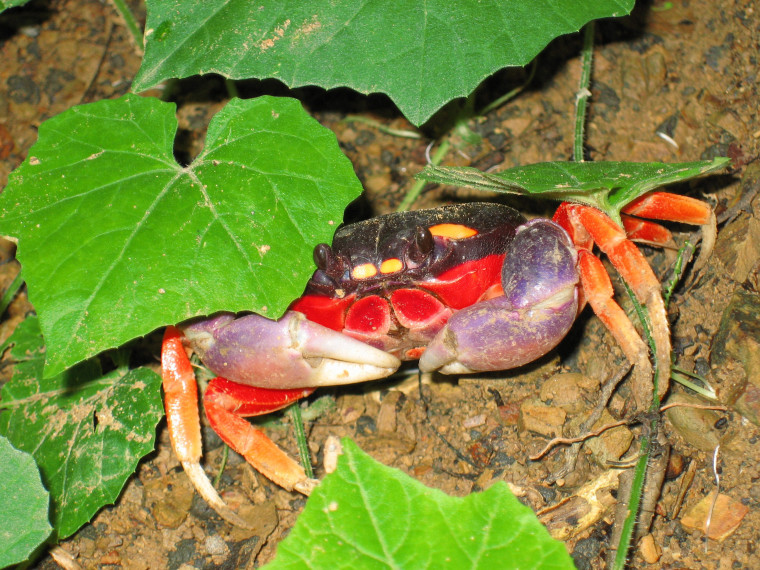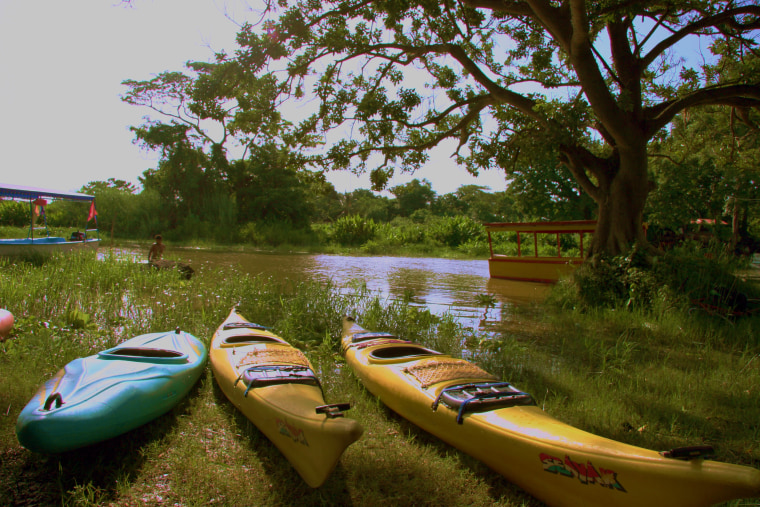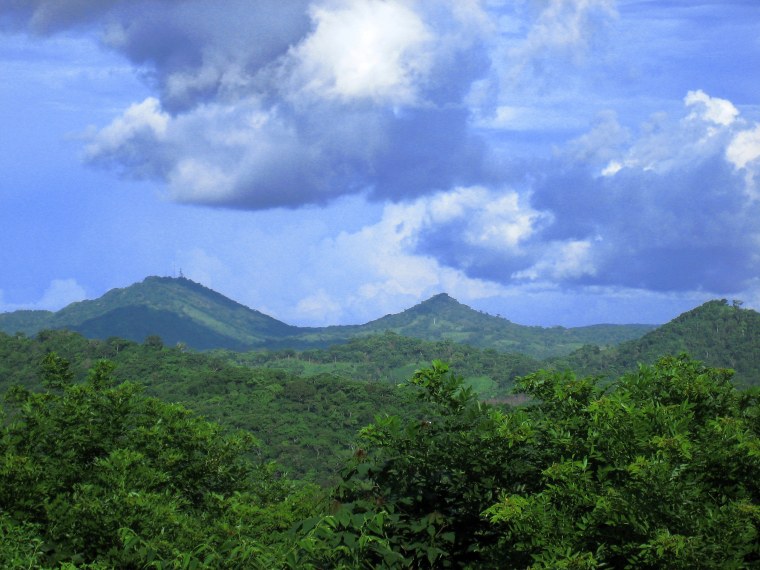In the mid-70s New Yorker Michael Kaye skritched his way to Central America to spend a season surfing. He landed in Costa Rica, which then had little infrastructure and less tourism. He recognized the potential, and started a little business that took clients hiking through the cloud forests, rafting the russet rivers, exploring the piping volcanoes. He built a series of small environmentally-friendly lodges in the jungles, and pioneered a style of travel that would come to be called ecotourism. Thirty years later Costa Rica is the ecotourism capital of the world, with a gadarene rush of some 1.4 million visitors last year, and with so many lodges and operations flying under the eco-banner that the defining qualities of wildness, diversity, fertility and isolation are creaking under the green-leaning crowds.
It comes as no surprise, then, that ‘the godfather of ecotourism,” as Michael has come to be known, has turned his attention to new contours to the north in recent months, to a place that might be compared to Costa Rica before the swarm, a once-troubled country finally bathed in peace, and blessed with natural Bianca beauty: Nicaragua.
So, when Michael invited photographer Sally Solaro and me to join on a reconnaissance of Nicaragua, we accepted with alacrity. We rendezvoused in Granada, the colonial capital on the shores of Lago de Nicaragua, only a hop from Costa Rica on a new air taxi, Nature Air. Michael looked so much different than when I knew him in the 70s…then he passed for a jaunty Che Guevera, with a long black unkempt beard, insurgent hair and leather sandals….he was, in a manner of speaking, a sandalnista. Now Michael has transformed not only the travel industry, against its will I should add, but himself, sporting natty Ex Officio wear, his chin porcelain smooth, and his hair a short, neat George Clooneyesque crop specked with grey. “We all change. Tourism has changed. Countries change. Fourteen years ago Nicaragua was unthinkable as a travel destination. Now it’s the safest place in Central America, at the brink of a tourist revolution,” Michael beams in explanation.
The Nicaragua that capers in my mind is from chilling images from the late 70s, a country then of rapine and fire, bleeding in civil war. The conflict ended with the Sandinistas' 1979 overthrow of the Somoza family's corrupt, four-decades-long regime. Then came the dozen years of postwar fighting as the American-backed contra rebels -- with the assist of a U.S. embargo -- tried to push the Sandinista Front of National Liberation out of power.

The embargo was lifted after the Sandinistas lost the 1990 presidential election. Foreign investment dipped toes in, some adventurers poked about, including Michael. Quietly the country has returned to a state of grace. Visitor numbers has increased 170% since 1993, from 200,000 to 525,000 last year; tourism dollars increased some 400% in the same time frame, from $30 million to $150 million. And Michael thinks the tourism volcano is just beginning its tremblers.
We begin our own discovery with a kayak tour of Lago de Nicaragua, a lake too vast to see across, second largest lake in all the tropics, where 20 years ago guerillas skulked among the broad-leafed trees of the 365 volcanic islands. Now the islands are garlanded with Century 21 signs offering pieces of paradise to snowbirds. The one occupied tree we encounter is festooned with a leggy spider monkey sporting a Daniel Ortega-like moustache. He would look better without the facial hair, Michael suggests.
We rotor across water the temperature and color of tea. In the middle distance the mile-high Mombacho Volcano lushly blends with an uncertain sky. We glide beneath a rainbow of feathers, from tropic cormorants to Amazon kingfishers to green herons. Along the shore are bright emerald clusters of sea lettuce (Chlorophyta), water hyacinth, giant mango trees, the fruit tree called poponjoche, and the bright-blossomed national flower, the Sacuanjocheink. Outlying islands look like green animals in repose. The whole world seems alive here, top to bottom.
Like Mesoamerican warriors we whip back to shore, and seize one of the many horse-drawn buggies that spindle in and about the dreamlike city of Granada. Not long ago the ghosts of the Chorotega Indians haunted this city, crossing telephone wires to kindle intrigue and evocations of clashes with the Spanish who settled here in 1524, one of the earliest foreign settlements on the continent. But self-pity is absent now. The mood is one of hope, lambent optimism for the future, and the streets are busy, wares, from hammocks to human hair brushes to hawksbill turtle shells, are being hawked with zest; children are skylarking in the alleys.
Michael takes the seat looking backwards, quipping it is because he likes looking back to a land that is like Costa Rica 27 years ago. We clop along past Spanish-style pastel-hued houses, under palms and pepper trees, by clumps of old men with leathery skin stretched tight over high, sharp bones, alongside energetic murals, beneath baroque cathedrals with big cedar doors, and beside shops flogging crocodile boots and Cuban cigars. We make it to San Juan de Oriente, the ceramic capital of the country. But unlike destinations where touro-dollars have spawned factories of kitsch, here the craftsman work in small cooperatives, or from their homes, and create superb works celebrating a pre-Columbian style. We watch in one darkened room as a master spins the clay to a plate while his young daughter crouches in the corner doing her homework, a tableau unique to this time and place.
During the California gold rush ships sailed south from New York to the mouth of Nicaragua’s Rio San Juan. Gold miners then boated up the 100-mile-long river to Lago de Nicaragua, and then made a 15 mile overland trek to the Pacific Ocean, where another ship took them north to San Francisco. This was also the route that for many years was considered the preferential path for a trans-ocean canal, but politics (and caveats about the dangers of volcanoes) pushed it to Panama. Now we trundle this route that never was the final miles towards the Pacific. A couple miles before the coast we turn down a dirt road outstanding in the number and quality of its ruts to make our way to the first five-star eco-resort in Nicaragua, Morgan’s Rock Hacienda and Ecolodge.
Named not for Captain Morgan of pirate and rhum fame, but rather Alabama Senator John Tyler Morgan (1824-1907) who championed the Nicaraguan canal route, the resort sits atop a shimmering bay overlooking a giant reef crag that the honorable Morgan supposedly proclaimed as the Pacific egress of the canal.

Michael Kaye wrote the urtext on ecolodges. And as we step up the German-engineered suspension bridge to our bluff chalets on a curved hillside above the bay, he observes that Morgan’s Rock benefits from the “low expectation factor.” Nobody really believes Nicaragua could host an Aman-style eco-resort.
The chalets have their backs to the hillside and their fronts up on stilts, creating the impression of being in a tree house. The main rooms are open on two sides, giving floor-to-ceiling views out through the trees to the beach and the sea. The effect is to blur the boundaries between inside and out. “Awesome,” Sally, who is a critic of Andrew Harperesque standards, appraises.
Spacious and intricately designed, the chalets combine contemporary simplicity and traditional materials. The columns are polished trunks of eucalyptus trees, the floor is made from thick boards of a lustrous dark reddish wood known as guapinol, and the walls are hand-cut chunks of volcanic rock. The furniture is all hand-made by local artisans. There are open-air showers, private gardens, and terrace decks, where locally grown coffee is served pre-breakfast.
The resort even has its own signature sound system, defined by invisible frogs that have a croak somewhere between a quaking duck and a bleating goat. But after a spell this is the noise to lock out, the noise to listen beneath, and there is then revealed an aural delight of hums and hymns, tintinnabulations and canticles of the rain forest.
The morning brings not only a vertiginous view of the curved-like-a-blade bay, but also green iguanas meditating inches beyond the balcony, looking like watercolors, or Tantric art. A branch away slings a troop of white-bearded howler monkeys, who also look as though they could use a shave here in the new Nicaragua. The country seems betwixt its tousled past and its clean-lined future, and this lodge carved into the heart of a primary rain forest seems an adept bridge.
Michael and his wife Yolanda love to bike, but on a tandem, and they shipped theirs on the Nature Air flight and brought it to Morgan’s Rock. The lodge property includes a reforestation project in which some 1.5 million trees, hardwood and fruit, have been planted in the last five years. They call visiting this part of the private sanctuary “agrotourism,” and it is optimized for biking, with labyrinthine back roads and trails that pitch through fields and forests practically vibrating with more shades of green than the spectrum allows.
Sally and I hop on mountain bikes provided by the lodge and take off with a whirr of derailleur gears, tooling about alongside Michael and Yolanda, sending up blooms of blue butterflies, feeling tough and kinetic as we pass beneath a mother and baby brown-throated three-toed sloth. Afterwards we grab sea kayaks on the deserted beach and bevel out and around the eponymous rock, to within spitting distance of Costa Rica. Then to complete the adventure triathlon we hop on horses, and go galloping down a jungle path, holding back as an agouti paca, a tropical rodent that looks like a cross between a rabbit and a squirrel, ruffles across the road.

After the incongruous luxury of Morgan’s Rock we head back to Granada, and walk its cobbled streets in the silky afternoon air. The entire city was gutted by William Walker, the American filibuster who declared himself president of Nicaragua in 1856, and was shot by firing squad four years later. The city has been given a face lift, freshly painted in mustard, peach and salmon, and now looks more like a colonial city than in its heyday. “Transformation is more often that not good,” Michael comments in his koan-like way. He offers himself as proof…he went from hippie to hotelier and harbors no regrets. Nicaragua has transformed from hot zone to hot destination. History, the lesson seems, is simply a rough draft. As we walk west off the southwest corner of the plaza we pass a sign that says “007 Barbershop,” and Michael lights up, and pulls me inside. “Time for you to transform,” he suggests, his merry eyes filled with the Pied-Pipered lanterns of the old mystery tour itself.
I sit down in a torn red vinyl chair, and my barber, Luis, in his bleached white guayabera, pulls out a straight razor and sharpens it on a belt, something I’ve only seen in movies. “What do you want cut?” Luis asks. Caught up in the moment, I look in the mirror and see a moustache I have sported for 30 years…it is disheveled, streaked with gray, with wild hairs leaping out in all directions. “Shave it off,” I say, pointing to the moustache. Before I can reconsider it is gone. I don’t recognize my face at first…it seems to hang like a lantern with a chalk-white upper lip. But then I warm to the fine finish, the cleaner grown-up look as the haircut continues. By twinkling transmutation a barber shop in Nicaragua becomes a magic glass into which I stepped, and then step out with a past elided, and a future thick with possibilities.
Richard Bangs is founding partner of the adventure company Mountain Travel/Sobek, author of 14 adventure travel books.
